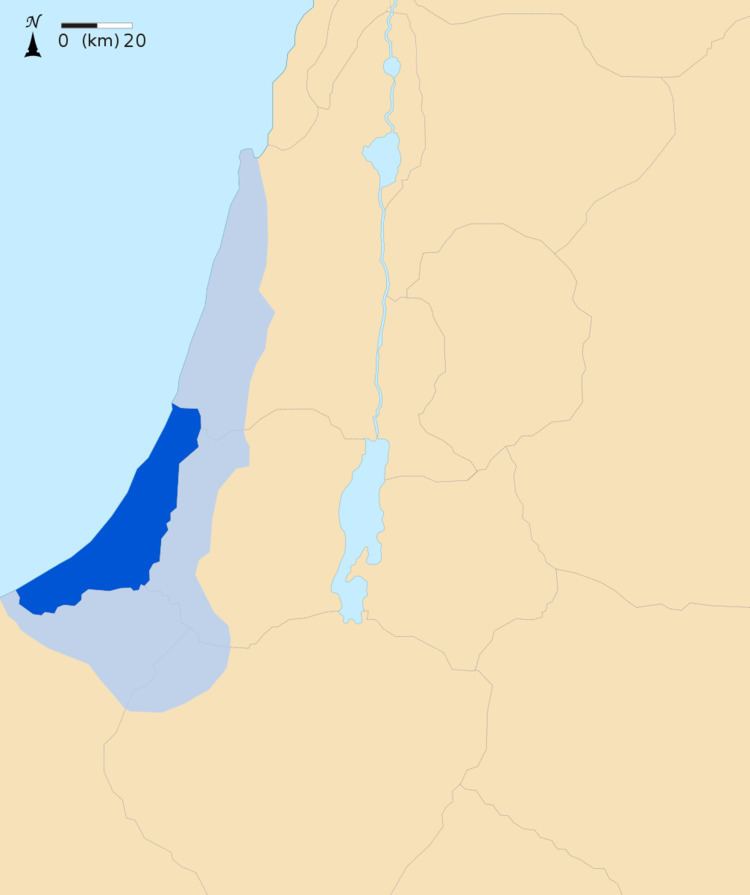Extinct ca. 9th century BCE Glottolog None | ISO 639-3 None (mis) | |
 | ||
Language family UnclassifiedIndo-European? | ||
The Philistine language (/ˈfɪləstiːn/, /-staɪn/ or /fᵻˈlɪstᵻn/, /-tiːn/) is the extinct language of the Philistines, spoken—and rarely inscribed—along the coastal strip of southwestern Canaan. Very little is known about the language, of which a handful of words survive as cultural loan-words in Hebrew, describing specifically Philistine institutions, like the seranim, the "lords" of the Philistine five cities ("Pentapolis"), or the ’argáz receptacle that occurs in 1 Samuel 6 and nowhere else, or the title padî.
There is not enough information of the language of the Philistines to relate it confidently to any other languages: possible relations to Indo-European languages, even Mycenaean Greek, support the independently-held theory that immigrant Philistines originated among "sea peoples". There are hints of non-Semitic vocabulary and onomastics, but the inscriptions, not clarified by some modern forgeries, are enigmatic: a number of inscribed miniature "anchor seals" have been found at various Philistine sites. On the other hand, evidence from the slender corpus of brief inscriptions from Iron Age IIA-IIB Tell es-Safi demonstrates that at some stage during the local Iron Age, the Philistines started using one of the branches (either Phoenician or Hebrew) of the local Canaanite language and script, which in time masked and replaced the earlier, non-local linguistic traditions, which doubtless became reduced to a linguistic substratum, for it ceased to be recorded in inscriptions. Towards the end of the Philistine settlement in the area, in the eighth to seventh centuries BCE, the primary written language in Philistia was a Canaanite dialect that was written in a version of the West Semitic alphabet so distinctive that Frank Moore Cross termed it the Neo-Philistine script. The Assyrian and Babylonian wars and occupations destroyed the Philistine presence on the coast. When documentation resumes, under the Persian imperium, it is in the Aramaic language, the empire's lingua franca.
Thus, to judge from the more numerous later inscriptions alone, it could misleadingly appear that the Philistine language is simply part of the local Canaanite dialect continuum. For instance, the Ekron inscription, identifying the archaeological site securely as the Biblical Ekron, is the first connected body of text to be identified as Philistine. However, it is written in a Canaanite dialect similar to Phoenician.
Philistine as an Indo-European language
There is some limited evidence in favor of the suggestion that the Philistines did originally speak some Indo-European language, which would help explain the markedly Aegean Greek origin of Philistine pottery styles and decorative motifs, particularly Philistine Bichrome ware. A number of Philistine-related words found in the Hebrew Bible are not Semitic, and can in some cases, with reservations, be traced back to Proto-Indo-European roots. For example, R.D. Barnett traced the Philistine word for captain, seren, which may be related to the Neo-Hittite sarawanas/tarawanas or the Greek word tyrannos (itself possibly borrowed from one of the languages of western Anatolia). and Edward Sapir made a case for kōbá, "helmet", used of Goliath's copper helmet. Some Philistine names, such as Goliath, Achish, and Phicol, appear to be non-Semitic in origin, and Indo-European etymologies have been suggested. Recently, an inscription dating to the late 10th/early 9th centuries BC with two names, very similar to one of the suggested etymologies of the popular Philistine name Goliath (compare Lydian Alyattes, Greek Kalliades) was found in the excavations at Tell es-Safi/Gath. The appearance of additional non-Semitic names in Philistine inscriptions from later stages of the Iron Age is an additional indication of the non-Semitic origins of this group.
